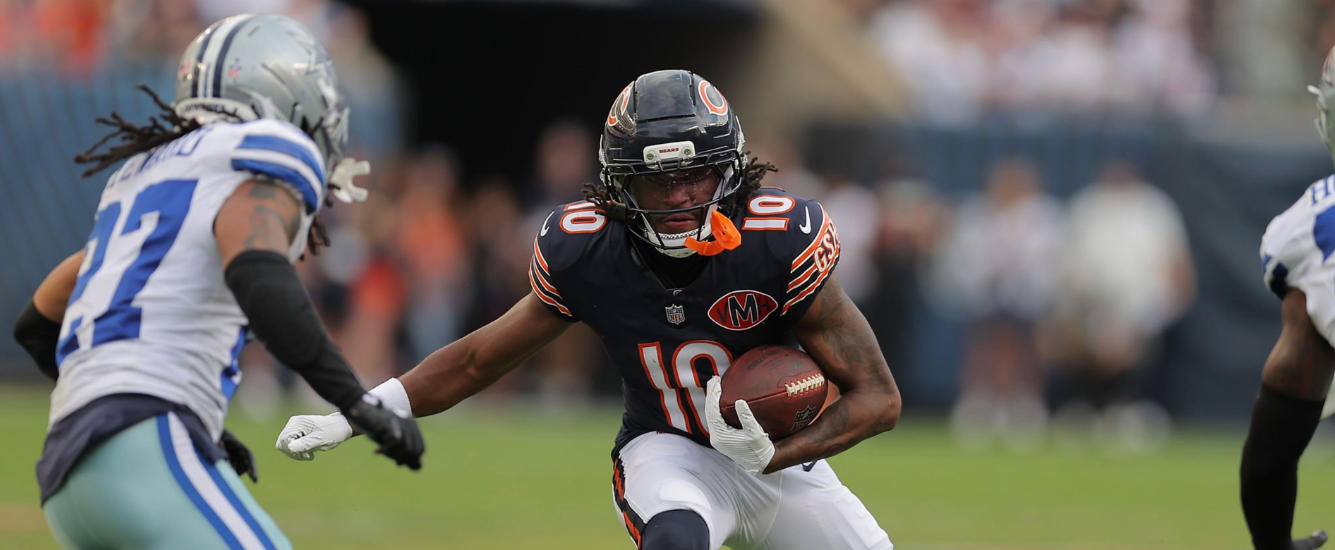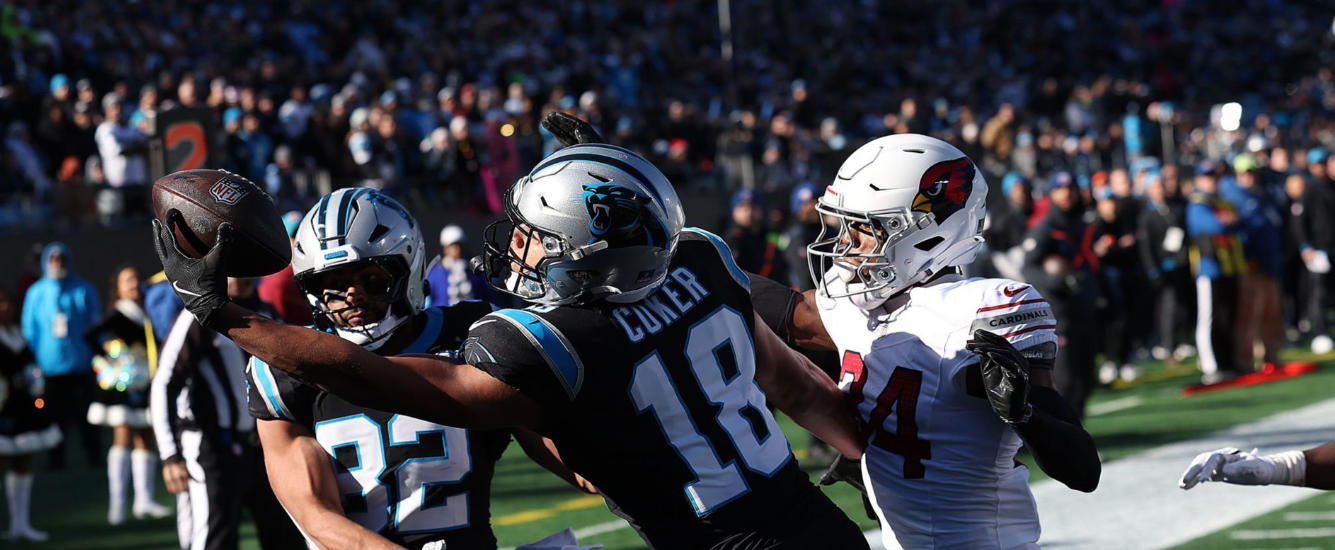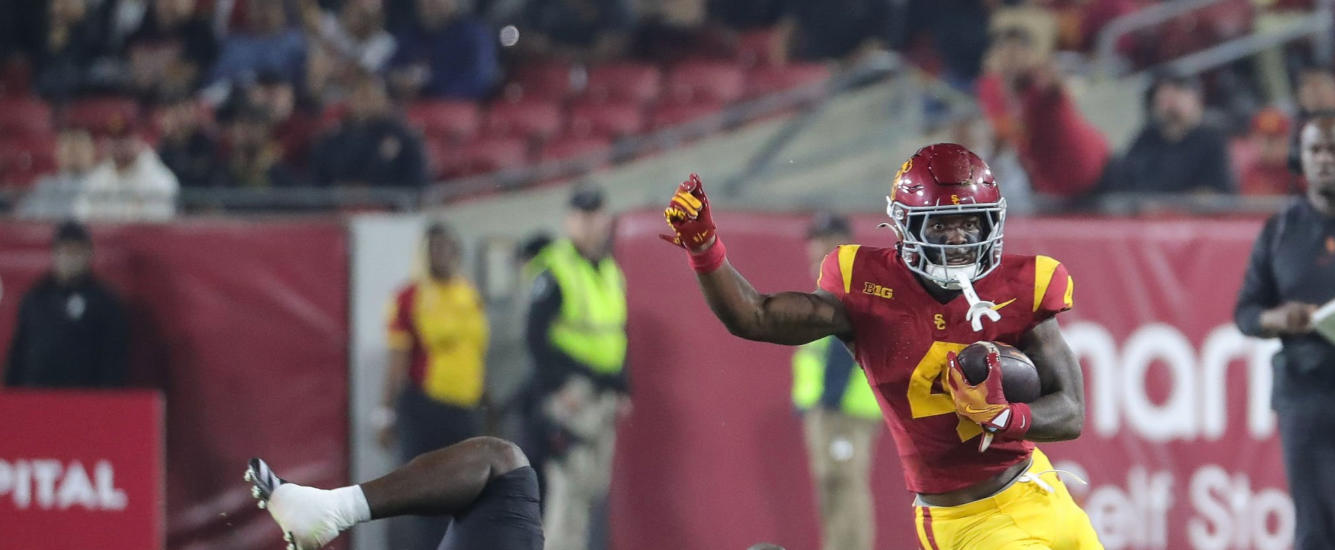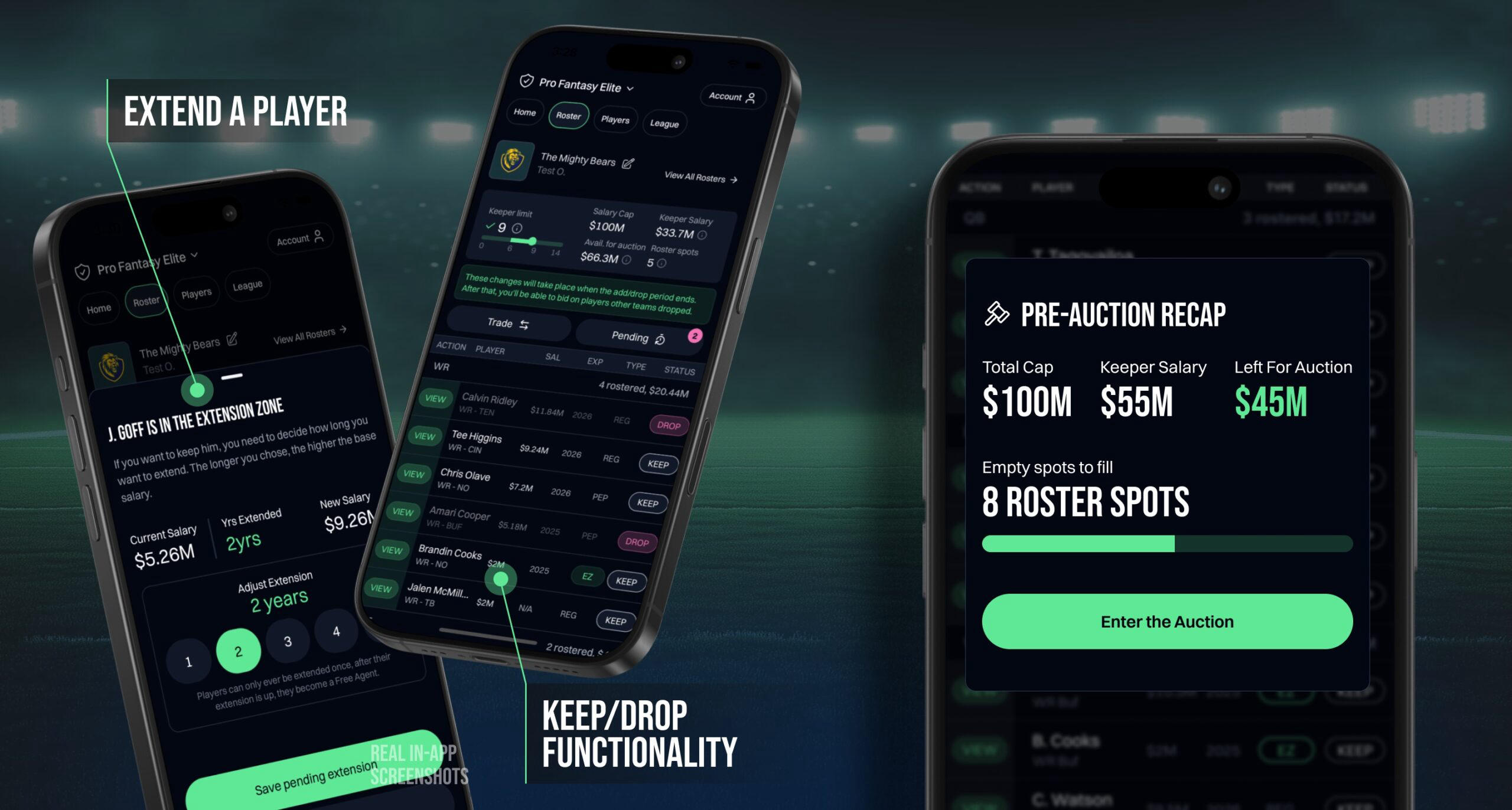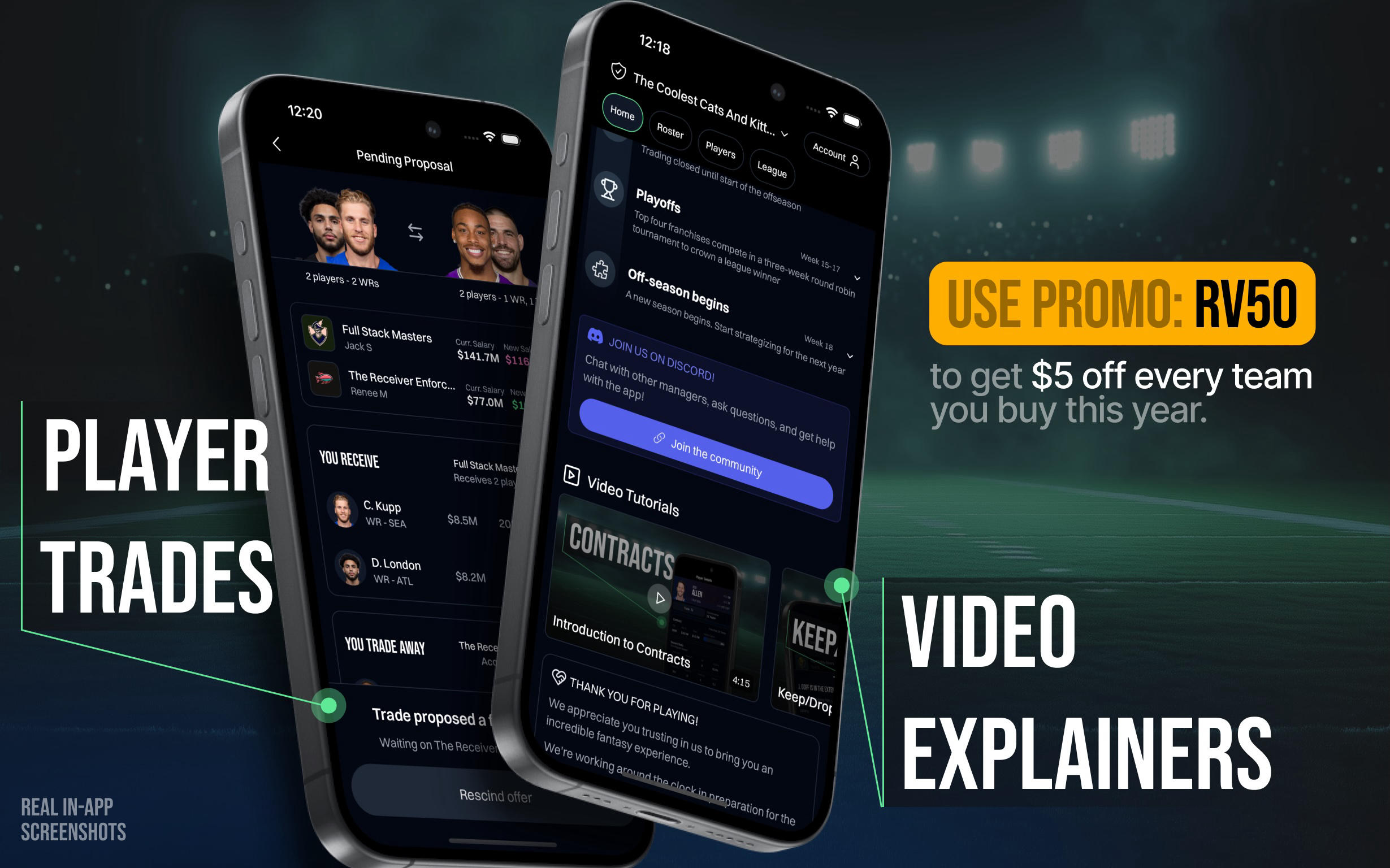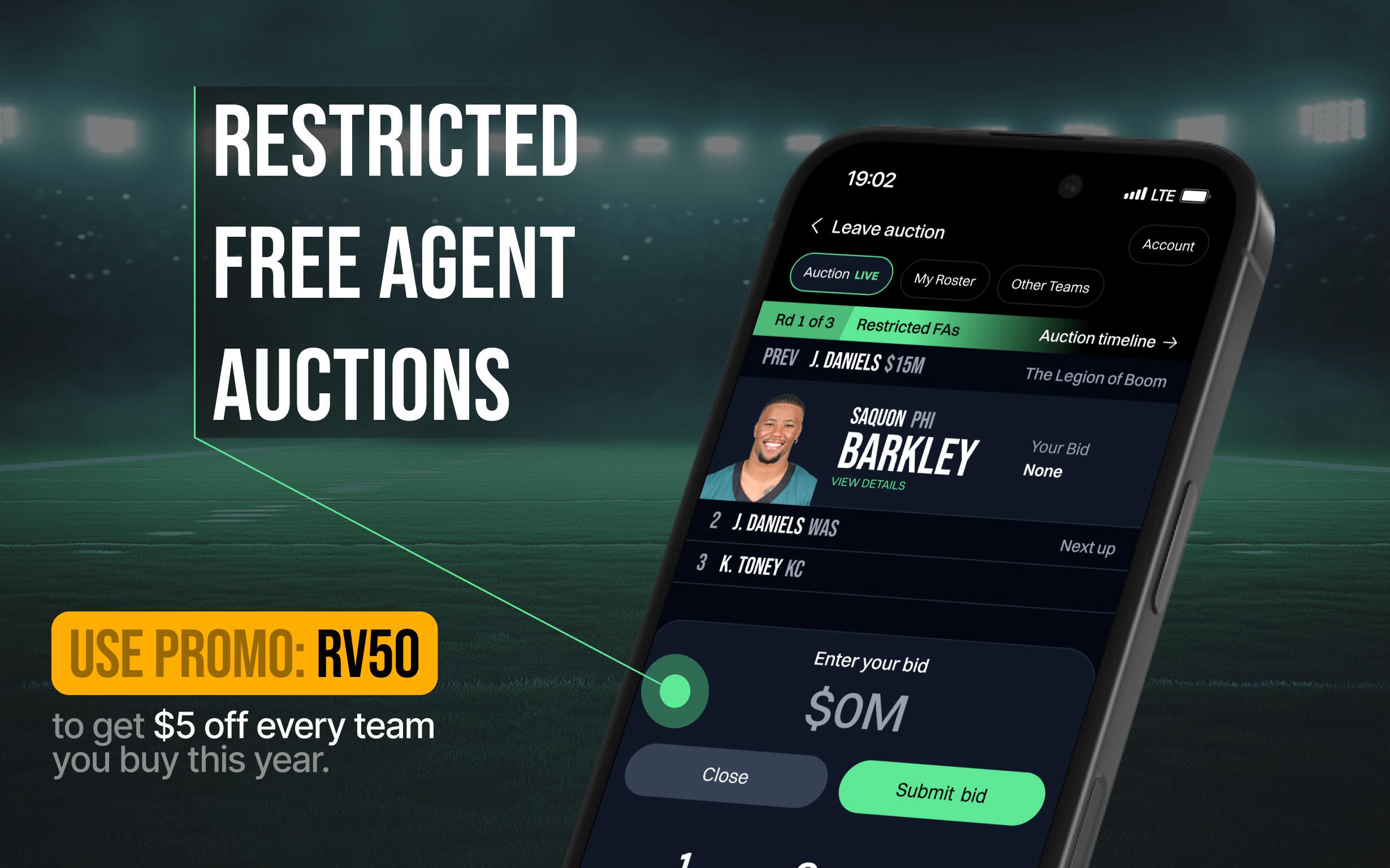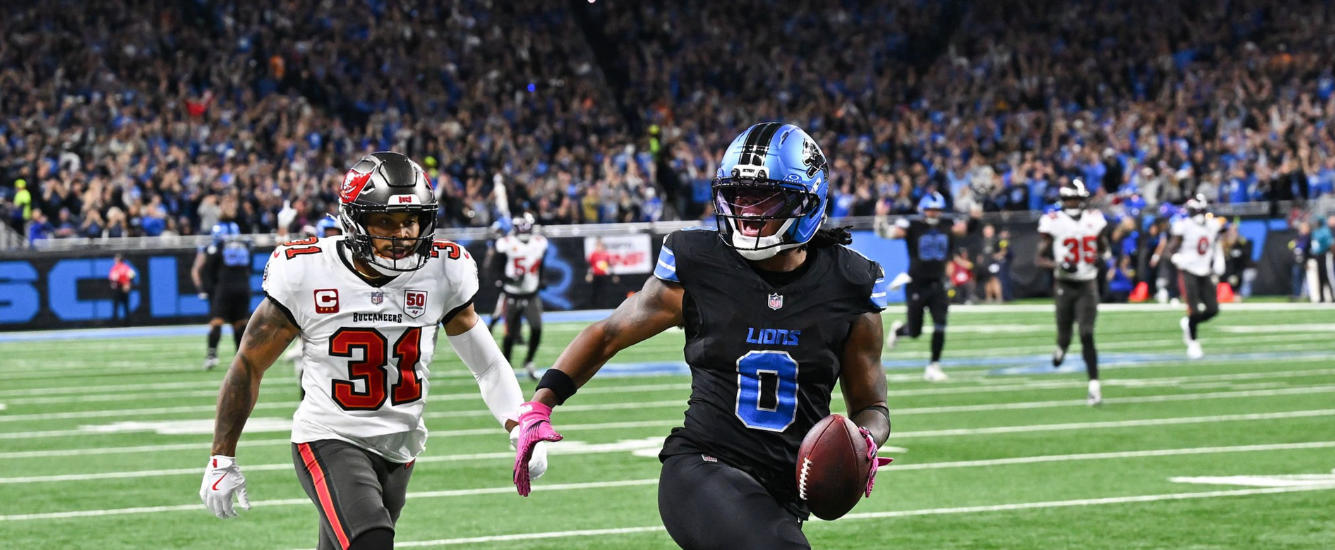Last week, Renee introduced the Franchise League Football format of dynasty fantasy football (FLF). Today she digs deeper into the strategy of managing a team.
Once your league is full, the commissioner will “activate” the preseason, which means the starting 14-man rosters will be randomly assigned to each fantasy GM. We employ an algorithm that draws on one of 10 realistic contract databases to assign players to each franchise in the league.
Player contracts may be regular (REG, expiring in 2025 or 2026), restricted free agent (RFA, can be kept but will be subject to league-wide blind bidding in the first round of the auction), in the extension zone (EZ, in the third year of their original contract and eligible to be kept and extended for a small salary increase) or previously extended (PEP, can be kept, but will become a free agent when their contract expires).
Prior to the preseason auction, each fantasy GM must cut their roster to between six and nine players. This serves several purposes. First, things change fast in the NFL, and what looked like a great player on a great contract in 2024 may not be so appealing today. You can cut the dead weight, freeing up extra salary to snap up this year’s hottest players in the free agency auction. Second, it more closely mimics the NFL. Real players don’t stay on their team forever. Savvy coaches and GMs are always mixing it up, and although the player doesn’t get a say in FLF, this format encourages a lot more player movement than a traditional dynasty league. Lastly, the keep/drop period forces you to think ahead strategically to where you want your franchise to be heading into this year’s auction, next year, and beyond. Though you’re taking on a seasoned roster, this is your first chance to shape it into the winning dynasty we all crave.
Today, I’ve invited my friend and colleague, Dave Sukoff, who was instrumental in developing this game from the beginning, to analyze our keep/drop decisions in the inaugural FLF league. Dave has played what is now FLF with his MIT classmates for two decades, continually tweaking and upgrading the format until it achieved the perfect balance of fun and strategic decision-making. He’s also a partner of the tech firm, Scope Labs, which is building FLF for the masses.
Using RotoViz tools, my expertise in cognitive biases, and Dave’s unique knowledge of and history with the game, we’ll go player by player to analyze our keep/drop decisions.
Renee’s Rebels
The Starting Roster
(Green = kept; red = dropped to the free agent pool)
Bo Nix – $2.5M
Nix finished 2024, his rookie season, as QB8 overall and QB11 in fantasy points per game. Denver was a middling offense with no superstar playmakers on the roster, but the defense put him in position to break out fantasy-wise. Nix ranked sixth in pass attempts with solid rushing numbers. Second-year players often focus on limiting mistakes and expanding the playbook. To that end, the Broncos added Evan Engram to the roster while bringing back the same wide receiver corps Nix was getting comfortable with at the end of 2024 (especially Marvin Mims, who led the league in YAC per reception at 12.2). Nix could be the next C.J. Stroud or the next Josh Allen, but at near minimum salary, he’s a no-brainer keeper for me.
Dave: Nix is in Tier 2 of QBs, but at a near minimum salary, he likely provides much more value than the elite group. I have Lamar at $10.7M in the final year of his contract — I would prefer Nix at $2.5M just getting started.
Bryce Young – $2M
I somewhat buy the second-year hype around Young and am truly hoping for the best, but he’s not the player I want to build my franchise around. Even in a league where I want two QBs (in-game injury replacement makes that a necessity), I’ll be able to scoop up someone with a higher floor during my auction.
Christian McCaffrey – $19.6M
This was a controversial keep, I get it. The salary is really high, last year was rough for anyone with the 1.01 (only once for me), and none of us know the truth about McCaffrey’s health or usage plan. We do know what he can do when he’s 80 percent or better in this potent 49ers offense and that was enough for me when staring down this generally unappealing starting roster. After all, I had to keep at least six players! I won’t leave the auction without backup in the form of Isaac Guerendo (hopefully healthy soon) or rookie Jordan James.
Dave: I had offered Renee a 2-for-1 trade, which would have gotten her to six viable keepers. She passed, and then decided to keep an overpriced McCaffrey. It is not a terrible keep, but a franchise struggling to get to the minimum, or even under the maximum, should be working on a trade.
Renee: I wouldn’t have kept either of the players I was being offered, so I was ultimately happier rolling the dice with McCaffrey, especially as I’m adjusting to the new format.
Aaron Jones – $13.7M
Jones is another player I’m not thrilled to keep, nor one I’m targeting in other fantasy formats. The 30yo back is very unlikely to exceed last season’s mediocre production with a new QB in JJ McCarthy, but there also isn’t anyone behind him threatening his workload. Jones is a solid option as injury relief or to fill in bye week vacancies, but I’m hoping not to rely on him as an every-week starter.
Dave: He is overpriced. And this keep is worse than McCaffrey. If a franchise is going to overpay, better to do so closer to the top of the rankings, where scarcity naturally should increase value. Maybe a 3-for-1 trade was needed!
Gus Edwards – $8M
Second easiest decision ever.
Tyjae Spears – $5.7M
I like Spears quite a bit, but he’s not worth this much over the minimum contract. Still running behind Tony Pollard in an offense that seems to be laser-focused on improving the pass game makes him a (sad face) drop for me.
Jonathan Brooks – $4.2M
Easiest decision ever. This really wasn’t a great starting roster, was it?
Amon-Ra St. Brown – $9.7M
Finally, some good news. Everyone is keeping St. Brown at this outrageous bargain.
Dave: Bargains like this and Nix are what build a great franchise.
Zay Flowers – $7.5M
Can the Ravens’ third-year receiver truly break out this season? In two years, he’s shown flashes of the greatness that made him a first-round draft selection, but at the end of the day, Baltimore is a team that runs the ball, ranking 31st in pass attempts in 2024. Flowers is being drafted as WR25 this season, which feels about right. I kept Flowers for the potential for upside in an offense that has nowhere to go but up in the passing department.
Dave: The preference would have been not to keep Flowers — too expensive. It’s the price, not the player. I agree on his upside, but there is plenty of upside that will go for less money. Needing to get to six keepers, it was probably the right decision.
Keenan Allen – $2M
So, this decision was made with incomplete information, as it turns out. I’m convinced that Kevin Szafraniec is right about Justin Herbert, and now that it’s looking increasingly likely that Allen will be returning to the Chargers to be an immediate starter, I have regrets.
Dave: This is why I prefer later auctions/keeper deadlines. Every franchise could have this happen to them, so in theory it’s fair.
Renee: Dave literally set the auction date.
Adam Thielen – $2M
If hanging out with the old-school RotoViz crew taught me anything, it’s that there is nothing wrong with ageism in fantasy football. Thielen isn’t the long-term solution for Young and the Panthers, and he’s not a building block for my franchise either.
Mark Andrews – $10.9M
This league has Brock Bowers as a free agent, and I intend to use my ample available salary to lock him down during our auction. Ageism may have sneaked in here again, since while I would never choose to keep two Baltimore receivers, I went with the lower (positionally) ranked guy in Flowers. While I’m confessing to my own cognitive biases here, I also can’t forgive Andrews for not getting out of the way of Isaiah Likely, one of my worst (read: favorite) dynasty decisions ever. Hope does not spring eternal though; I want no part of a Ravens tight end in fantasy football.
Dave: Totally agree on dropping Andrews — though it seems I like him more than Renee. And it is important to take a look at who might be available in the auction at any position. But you also have to look at how much money other franchises might have, and I am predicting Bowers is going to go for quite a lot. With the blind bidding process, it is really difficult to lock in on any particular player.
Brian Grupe – $2M
There’s nothing wrong with keeping a kicker, if he’s Brandon Aubrey or Jake Bates at minimum salary, but Grupe? No thanks. I’m sure he’s a fine person, but he’s not even the top Brian Grupe in a Google search (he’s third behind a musician and a Las Vegas businessman if you’re curious).
Denver Broncos – $2M
Defense wins championships, so they say. If you can lock up the top option at any position for the minimum salary, you have to do it. So I did, and thank goodness, because six keepers felt like an awful lot with my starting squad.
Dave: Denver is the top option, and one of a few worth more than the minimum salary.
Summary
How I do in the auction will be crucial. I’m up against managers with much better starting material, but way less salary cap to spend. With around $45M, I should be able to clean up. It’s a bit of a mind-bend, starting out with a roster with at least two probable benchwarmers instead of a first and second-round draft pick. But I’m here for the mind-bending. This format is opening my eyes to a whole new way of evaluating fantasy players. I’ve got a lot to learn. Thanks for following along on the journey!
Dave: It was a tough starting hand to be dealt, but two huge values in Nix and St. Brown. In hindsight, trading away those players for multiple keepers would have enabled getting to the six-keeper minimum without having to keep as many unwanted players. The auction will be key, where overpaying for some keepers can be mitigated by mining a few underpriced gems. And with a solid amount of cap space left, Renee should be able to land at least one first-round type of player.
Dave’s Dynasty
The Starting Roster
I started with a roster almost the opposite of Renee’s. There were no clear bargains like Nix or St. Brown. But it included two of the top five players in Chase and Barkley, as well as who I think are the top QB (Jackson) and TE (McBride). None of them came cheap. I did try to trade Barkley to free up some cap space, but I was likely too aggressive. I shifted to a strategy of going into the auction with essentially a playoff team and virtually no money left. I will be filling out the roster with minimum salary players and counting on my superstars to carry me through.
Lamar Jackson – $10.7M
I have him as QB1, and I’d probably pay twice this amount for him. It’s the last year of his contract, and I’m counting on him to lead this squad to a championship.
C.J. Stroud – $6M
Easy drop decision. At $6M, he is overpriced. More importantly, I have a $10M Jackson, and I will pencil in $2M for a QB2. Yes, that’s all I could afford anyway. To keep Stroud, I would have had to drop another high-priced player.
Saquon Barkley – $28.6M
It is a little more than I would like to pay for him, especially with limited cap space. Thus, I tried to trade him. However, for a top-three RB, I am willing to overpay. Top picks are scarce. Only a handful are typically available in an auction.
Chuba Hubbard – $7.5M
This was perhaps my toughest decision. Hubbard is a mid-level RB2. But the salary is attractive. With Barkley as my RB1, I am still good with a mid-level RB2. I likely do not have enough money to afford a solid RB3, but my focus on the auction is to grab two or three minimum-salary RBs and hope one of them emerges.
Tyler Allgeier – $6.6M
Couldn’t afford him. I wouldn’t keep him anyway at that price.
Tank Bigsby – $2M
Given that I need 2-3 minimum salary RBs, Bigsby might otherwise have been a good candidate to keep. But I think I can do better. Right now, I have him ranked as my lowest minimum salary RB. I would prefer Bhayshul Tuten to Bigsby. I don’t see Bigsby with franchise-changing upside — Tuten at least still has that rookie potential where if he’s solid, $2M will really transform my squad next year. I also believe strongly in letting other franchises make mistakes. Most likely there are RBs that I place a higher than minimum value on that will slip through.
Renee: What I would give for Bigsby at the minimum. At worst, it’s an even split with Travis Etienne, with Bigsby likely taking the goal-line work; at best, he wins the full-time job with his superior efficiency. Tuten’s college comps, per the RotoViz Prospect Box Score Scout, leave much to be desired.
Ja’Marr Chase – $18.7M
Another franchise in this league has Brian Thomas Jr. for $2M — which is where he would have been won in an auction last season. I prefer that contract to Chase’s. Still a layup decision to keep fantasy football’s top player. I would have paid $25M for him, so I still think a bargain at this price.
Rashee Rice – $2.6M (extended three years at a new salary of $8.7M)
I traded Terry McLaurin for Rice, taking advantage of the suspension bias. Sure, Rice is likely not playing until Week 6 or 7, but I now have a legit WR1 at a relatively low salary for the next four seasons (this season, plus the three I extended him for). I can make do with the rest of the squad to start the season, and then when Rice comes back, I will have a crazy 1-2 punch at WR. I’m always thinking about the upcoming season, but I’m also managing my franchise for the future. Rice offers a unique blend of present and future value.
Renee: I’m trying to keep an open mind on Rice. In our FLF format, he makes much more sense than in a standard redraft league. I probably wouldn’t have extended him for more than one year in order to keep his salary lower — it goes up $2M per year extended. He’s definitely shown some serious talent, but the majority of his games played have yielded unstartable fantasy production. Missing time due to injury, and now the probable suspension, makes it hard for Rice to integrate himself into the old Tyreek Hill role for the Chiefs.
Brandin Cooks – $2M
I’m not even sure who he plays for.
Renee: It’s the Saints, but yikes. I’m steering clear of even the younger New Orleans’ skill players if possible.
Trey McBride – $9.7M
There might be a debate at the top of the tight end chart, but I think it’s McBride. I think the salary is about fair, and since I have some relatively underpriced players elsewhere — like Chase, it made sense to lock in the best TE. I doubt I’d spend more than the minimum on anyone other than McBride or Bowers.
Renee: Jealous, so jealous. That’s all. I’d value him $5-6M higher than this in a must-start TE league like ours.
Cole Kmet – $2M
I wouldn’t keep him at the minimum, but I do like Colston Loveland’s upside.
Renee: Loveland fits the mold of the tight end seducer, with his only two significant comps being highly anticipated players at the tight end position in recent history. As a Bills fan, I’m holding fast to the line that Dalton Kincaid isn’t a bust (yet), but I’m also increasingly stingy with my trust when it comes to tight end prospects.
Brandon Aubrey – $5M
It’s rare that I would pay more than the minimum for any kicker. Aubrey might have been OK for $3-3.5M — though even that I would not have been able to afford this season.
Kansas City Chiefs – $2M
I will be paying minimum for a DST out of necessity, and I knew Renee had the Broncos. There are two or three other DSTs I prefer, and I could probably get Chiefs back at $2M if I miss on those others.
Summary
I started with a better hand than Renee, though that does not mean I will end up with a better squad once the auction is done. I have very little flexibility with no extra cap space left, and so I need to hit on several of my upside players. I agree, of course, that the journey is fascinating. Every roster spot decision is impactful, and every bid in the auction has the potential to impact your franchise for years. Enjoy!
Next week, we’ll run down how this auction actually plays out. Stay tuned.


